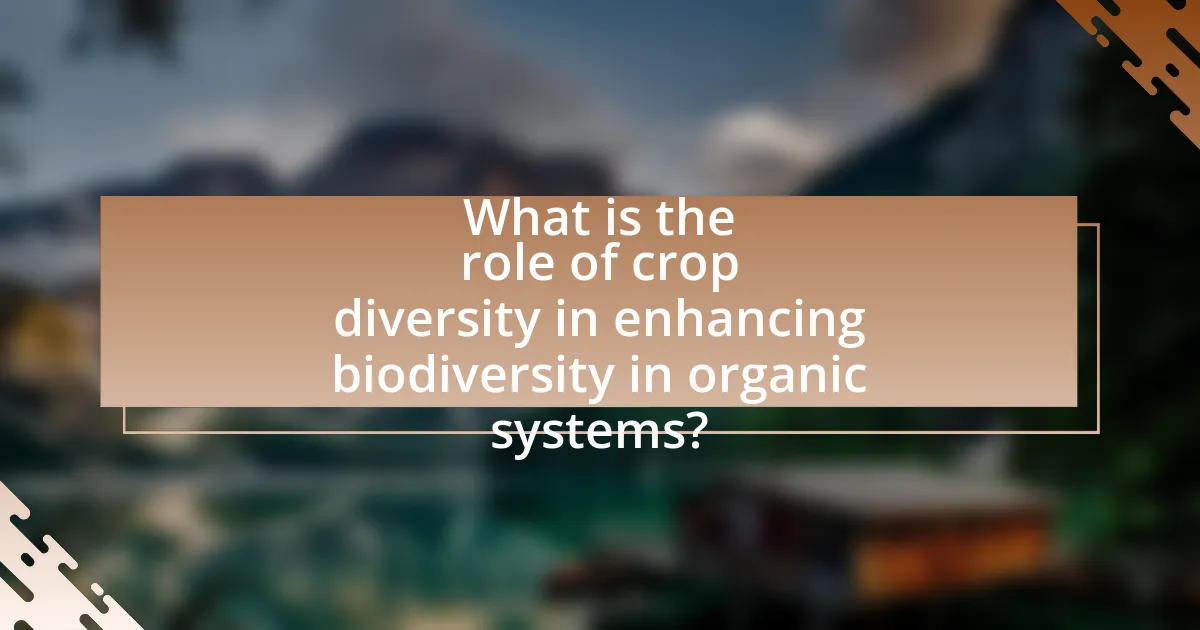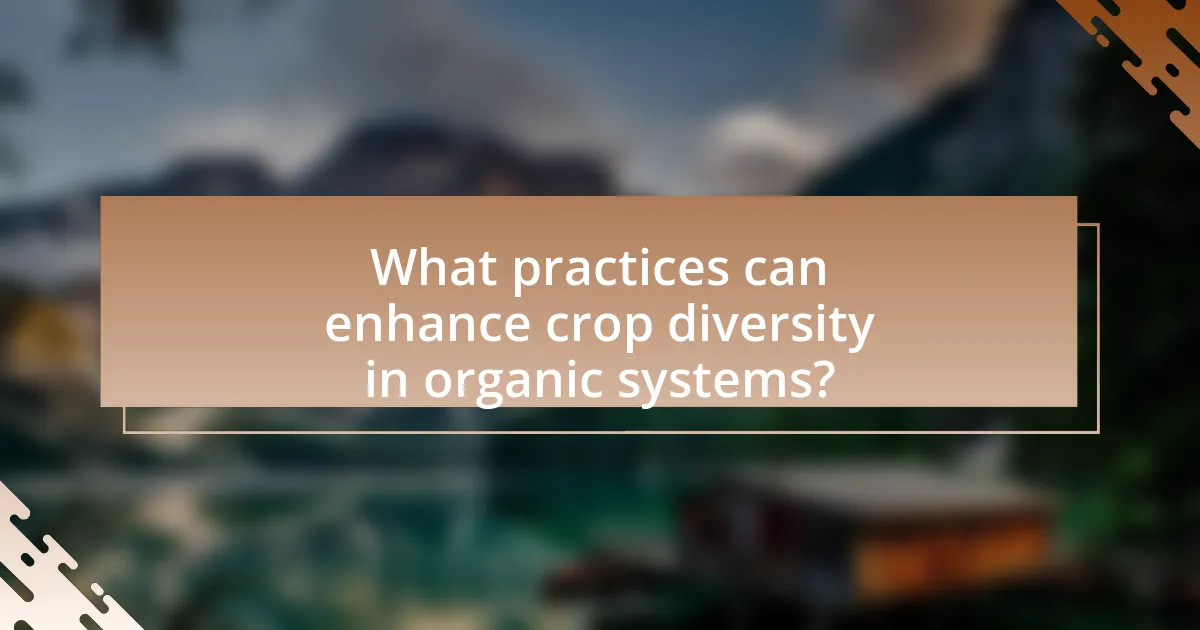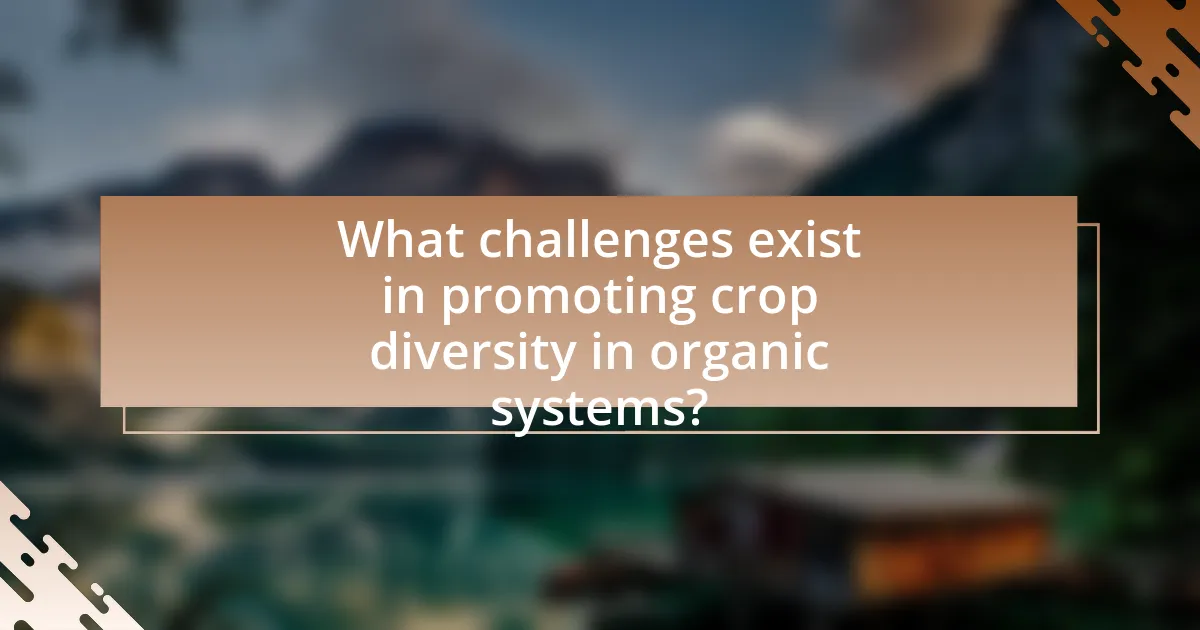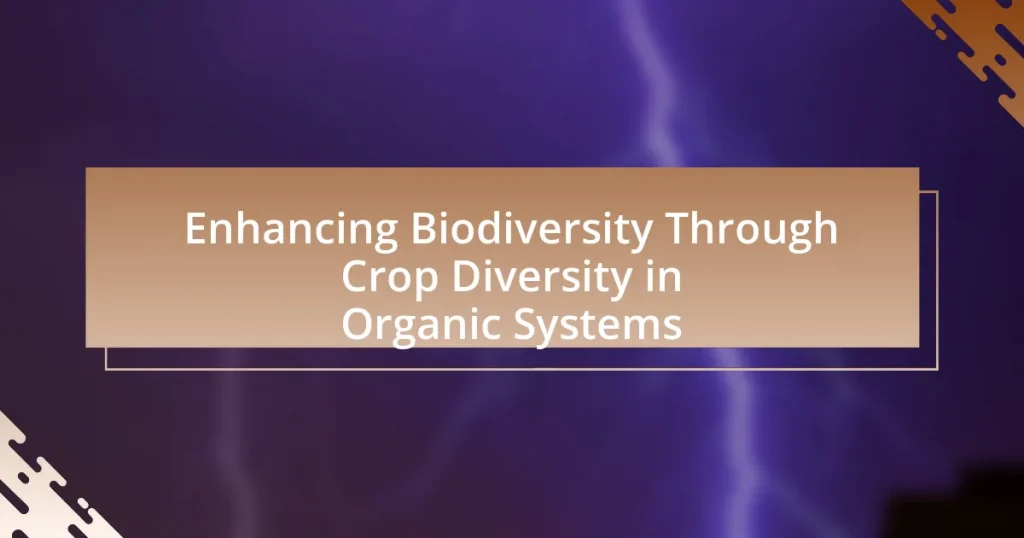The article focuses on the critical role of crop diversity in enhancing biodiversity within organic agricultural systems. It outlines how diverse cropping practices contribute to ecosystem resilience, improve soil health, and facilitate effective pest and disease management. Key benefits of crop diversity include increased soil fertility, enhanced nutrient cycling, and greater stability against environmental stresses, which are essential for sustainable farming. The article also addresses challenges in promoting crop diversity, such as economic barriers and limited access to seed varieties, while highlighting best practices like crop rotation, intercropping, and the use of cover crops to foster biodiversity and improve agricultural productivity.

What is the role of crop diversity in enhancing biodiversity in organic systems?
Crop diversity plays a crucial role in enhancing biodiversity in organic systems by promoting a variety of plant species that support a wider range of organisms. This variety creates more complex ecosystems, which can improve resilience against pests and diseases, as well as enhance soil health and nutrient cycling. Research indicates that diverse cropping systems can increase the abundance and diversity of beneficial insects, such as pollinators and natural pest predators, thereby contributing to overall ecosystem stability. For instance, a study published in “Agriculture, Ecosystems & Environment” by Tscharntke et al. (2012) found that increased crop diversity significantly boosts the richness of beneficial arthropods, which are essential for maintaining ecological balance in agricultural landscapes.
How does crop diversity contribute to ecosystem resilience?
Crop diversity enhances ecosystem resilience by increasing the variety of species within agricultural systems, which leads to improved stability and adaptability to environmental changes. Diverse crops can better utilize resources such as water and nutrients, reducing competition and promoting healthier soil ecosystems. Research indicates that systems with higher crop diversity can withstand pests and diseases more effectively, as the presence of multiple species disrupts the life cycles of harmful organisms. For instance, a study published in the journal “Nature” found that diverse cropping systems can reduce yield losses by up to 50% during pest outbreaks compared to monocultures. This evidence supports the assertion that crop diversity is crucial for maintaining ecosystem health and resilience.
What specific benefits does crop diversity provide to soil health?
Crop diversity significantly enhances soil health by improving soil structure, increasing nutrient availability, and promoting microbial diversity. Diverse root systems from various crops create a more complex soil structure, which enhances water infiltration and reduces erosion. Additionally, different crops contribute unique organic matter and nutrients to the soil, leading to improved fertility. Research indicates that fields with higher crop diversity exhibit greater microbial diversity, which is crucial for nutrient cycling and disease suppression. For instance, a study published in “Agriculture, Ecosystems & Environment” by Tilman et al. (2006) found that diverse cropping systems can increase soil organic matter and enhance soil microbial communities, ultimately leading to healthier soils.
How does crop diversity influence pest and disease management?
Crop diversity significantly enhances pest and disease management by disrupting pest life cycles and reducing the prevalence of diseases. Diverse cropping systems create a variety of habitats that support beneficial organisms, such as predators and parasitoids, which help control pest populations. Research indicates that polycultures can reduce pest outbreaks by up to 50% compared to monocultures, as seen in studies conducted by the University of California, Davis, which demonstrated that diverse plantings can lower the incidence of pests like aphids and whiteflies. Additionally, crop diversity can improve soil health and resilience, further contributing to the overall stability of the ecosystem, which is crucial for sustainable agricultural practices.
Why is biodiversity important in organic farming systems?
Biodiversity is crucial in organic farming systems because it enhances ecosystem resilience, improves soil health, and promotes pest control. Diverse plant and animal species contribute to a balanced ecosystem, which can better withstand environmental stresses such as drought or disease. For instance, studies have shown that farms with higher biodiversity can yield more stable outputs over time, as diverse crops can utilize resources more efficiently and reduce the risk of total crop failure. Additionally, biodiversity supports beneficial organisms that naturally control pests, reducing the need for synthetic pesticides and fostering a healthier farming environment.
What are the ecological benefits of maintaining biodiversity in agriculture?
Maintaining biodiversity in agriculture provides essential ecological benefits, including enhanced soil health, improved pest control, and increased resilience to climate change. Diverse crop systems contribute to soil fertility by promoting a variety of root structures and microbial communities, which improve nutrient cycling and soil structure. Research indicates that farms with higher biodiversity can reduce pest populations naturally, as diverse plant species attract beneficial insects that prey on pests. Additionally, diverse agricultural systems are more resilient to climate fluctuations, as they can better withstand extreme weather events and adapt to changing conditions. Studies show that farms practicing crop diversity can yield more stable outputs over time, demonstrating the critical role of biodiversity in sustainable agricultural practices.
How does biodiversity impact food security and nutrition?
Biodiversity significantly enhances food security and nutrition by providing a variety of crops that contribute to a balanced diet and resilience against pests and diseases. Diverse agricultural systems increase the availability of different nutrients essential for human health, as various crops offer unique vitamins, minerals, and proteins. For instance, a study published in the journal “Nature” found that crop diversity can lead to improved yields and reduced reliance on chemical inputs, which supports sustainable food production. Additionally, biodiversity helps maintain ecosystem services such as pollination and soil fertility, which are crucial for sustaining agricultural productivity. Thus, the relationship between biodiversity and food security is vital for ensuring nutritional adequacy and resilience in food systems.

What practices can enhance crop diversity in organic systems?
Practices that can enhance crop diversity in organic systems include crop rotation, intercropping, and the use of cover crops. Crop rotation involves alternating different crops in the same area across seasons, which helps to break pest and disease cycles and improve soil health. Intercropping, the practice of growing two or more crops in proximity, can increase biodiversity and optimize resource use, leading to higher yields. The use of cover crops, which are planted during off-seasons, enhances soil fertility and structure while suppressing weeds. Research indicates that these practices not only promote biodiversity but also contribute to sustainable agricultural systems by improving resilience against climate change and pests.
How can farmers implement crop rotation to increase diversity?
Farmers can implement crop rotation to increase diversity by systematically alternating different crops in the same field across growing seasons. This practice enhances soil health, disrupts pest and disease cycles, and improves nutrient availability. For instance, rotating legumes with cereals can fix nitrogen in the soil, benefiting subsequent crops. Research indicates that diverse cropping systems can lead to a 20-30% increase in yield stability compared to monocultures, as shown in studies by the Rodale Institute.
What are the best practices for selecting crops in rotation?
The best practices for selecting crops in rotation include choosing crops that complement each other in nutrient use, pest management, and soil health. Selecting legumes, for example, can enhance nitrogen levels in the soil, benefiting subsequent crops. Additionally, rotating deep-rooted and shallow-rooted plants can improve soil structure and reduce compaction. Research indicates that diverse crop rotations can lead to increased yields and reduced pest pressures, as demonstrated in studies by the Rodale Institute, which found that diverse rotations can enhance soil health and biodiversity.
How does crop rotation affect soil fertility and pest control?
Crop rotation significantly enhances soil fertility and pest control by diversifying plant species and their root structures, which improves nutrient cycling and disrupts pest life cycles. Different crops contribute varying nutrients to the soil; for example, legumes fix nitrogen, enriching the soil for subsequent crops. This practice reduces the reliance on chemical fertilizers, promoting a healthier soil ecosystem. Additionally, rotating crops can break the cycles of pests and diseases that thrive on specific plants, leading to lower pest populations and reduced need for pesticides. Research indicates that farms employing crop rotation experience up to a 25% increase in yield and a notable decrease in pest-related crop damage, demonstrating the effectiveness of this agricultural strategy.
What role do cover crops play in enhancing biodiversity?
Cover crops play a crucial role in enhancing biodiversity by providing habitat and food sources for various organisms, including beneficial insects, soil microbes, and wildlife. These crops improve soil health and structure, which supports a diverse range of plant and animal life. Research indicates that cover crops can increase the abundance and diversity of soil microorganisms, which are essential for nutrient cycling and ecosystem functioning. Additionally, studies have shown that fields with cover crops exhibit higher levels of insect diversity, contributing to natural pest control and pollination services.
Which cover crops are most effective for promoting biodiversity?
Leguminous cover crops, such as clover and vetch, are most effective for promoting biodiversity. These crops enhance soil health, provide habitat for beneficial insects, and improve nutrient cycling. Research indicates that leguminous cover crops can increase the abundance and diversity of soil microorganisms, which are crucial for ecosystem functioning. For instance, a study published in the journal “Agriculture, Ecosystems & Environment” by Snapp et al. (2005) demonstrated that fields with diverse cover crops supported a higher diversity of beneficial arthropods compared to monoculture systems. This evidence underscores the role of leguminous cover crops in fostering biodiversity within agricultural systems.
How do cover crops contribute to soil health and ecosystem services?
Cover crops enhance soil health and ecosystem services by improving soil structure, increasing organic matter, and promoting biodiversity. These crops prevent soil erosion, enhance nutrient cycling, and improve water retention, which collectively contribute to healthier soils. Research indicates that cover crops can increase soil organic carbon levels by 0.1 to 0.4% per year, significantly boosting soil fertility and microbial activity. Additionally, they provide habitat for beneficial organisms, thus supporting ecosystem functions such as pollination and pest control. Studies have shown that fields with cover crops can experience a 10-20% increase in overall biodiversity compared to those without, demonstrating their critical role in sustainable agricultural practices.

What challenges exist in promoting crop diversity in organic systems?
Promoting crop diversity in organic systems faces several challenges, including limited access to diverse seed varieties, economic constraints, and knowledge gaps among farmers. Limited access to diverse seed varieties restricts farmers’ ability to cultivate a wide range of crops, as many organic seed suppliers may not offer sufficient options. Economic constraints can hinder farmers from investing in diverse crops due to higher initial costs and market uncertainties. Additionally, knowledge gaps among farmers regarding the benefits and management of diverse cropping systems can lead to reluctance in adopting such practices. These challenges collectively impede the enhancement of biodiversity in organic agricultural systems.
What are the economic barriers to implementing crop diversity?
The economic barriers to implementing crop diversity include high initial costs, market demand for monocultures, and limited access to diverse seed varieties. High initial costs arise from the investment needed for infrastructure, equipment, and training to manage diverse crops effectively. Market demand for monocultures is driven by consumer preferences and the agricultural industry’s focus on uniformity, which discourages farmers from diversifying their crops. Limited access to diverse seed varieties is often due to monopolistic practices by seed companies, which restricts farmers’ choices and increases dependency on a few dominant crops. These factors collectively hinder the adoption of crop diversity in agricultural systems.
How can farmers overcome financial constraints related to crop diversity?
Farmers can overcome financial constraints related to crop diversity by implementing diversified cropping systems that enhance resilience and reduce risk. Research indicates that diversified systems can lead to increased yields and profitability; for instance, a study published in the journal “Agricultural Systems” found that intercropping can improve overall farm productivity by up to 30% compared to monoculture systems. Additionally, farmers can access financial support through government programs and grants aimed at promoting sustainable agriculture, which can alleviate initial investment costs associated with adopting diverse crops. By leveraging these strategies, farmers can effectively manage financial risks while enhancing biodiversity in their farming practices.
What support systems are available for farmers transitioning to diverse cropping systems?
Farmers transitioning to diverse cropping systems can access various support systems, including government programs, agricultural extension services, and financial assistance. Government programs, such as the USDA’s Conservation Stewardship Program, provide technical and financial support to promote sustainable practices. Agricultural extension services offer education and resources on crop diversity, helping farmers implement new practices effectively. Additionally, financial assistance through grants and low-interest loans can help cover the costs associated with transitioning to diverse cropping systems, enabling farmers to invest in necessary resources and training. These support systems are crucial for facilitating the shift towards more sustainable and biodiverse agricultural practices.
How does climate change impact crop diversity in organic systems?
Climate change negatively impacts crop diversity in organic systems by altering growing conditions, which can lead to reduced yields and increased vulnerability to pests and diseases. Specifically, rising temperatures and shifting precipitation patterns can limit the range of crops that can be successfully cultivated, thereby decreasing the variety of crops grown. Research indicates that regions experiencing extreme weather events, such as droughts or floods, often see a decline in the cultivation of diverse crops, as farmers may resort to planting fewer, more resilient varieties to mitigate risk. This trend threatens the genetic diversity essential for sustainable agriculture and ecosystem resilience, as evidenced by studies showing that diverse cropping systems are more productive and stable under climate stress.
What strategies can be employed to adapt crop diversity to changing climates?
To adapt crop diversity to changing climates, farmers can implement strategies such as selecting climate-resilient crop varieties, diversifying planting schedules, and employing agroecological practices. Climate-resilient varieties, such as drought-tolerant or heat-resistant crops, can withstand extreme weather conditions, thereby maintaining yields. Diversifying planting schedules allows for staggered harvests, reducing the risk of total crop failure due to climate variability. Agroecological practices, including intercropping and crop rotation, enhance soil health and biodiversity, which can improve resilience against pests and diseases. Research indicates that these strategies can significantly increase agricultural resilience, as demonstrated in studies showing that diverse cropping systems can yield up to 20% more than monocultures under stress conditions.
How can crop diversity mitigate the effects of climate change on agriculture?
Crop diversity can mitigate the effects of climate change on agriculture by enhancing resilience against pests, diseases, and extreme weather conditions. Diverse cropping systems improve soil health and increase ecosystem services, which are crucial for adapting to climate variability. For instance, studies have shown that polycultures can yield more stable outputs under changing climate conditions compared to monocultures, as they utilize resources more efficiently and reduce the risk of total crop failure. Additionally, research indicates that diverse crops can better capture carbon and improve nutrient cycling, further contributing to climate change mitigation.
What are the best practices for enhancing crop diversity in organic systems?
The best practices for enhancing crop diversity in organic systems include crop rotation, intercropping, and the use of cover crops. Crop rotation involves alternating different crops in the same area across seasons, which helps break pest and disease cycles while improving soil health. Intercropping, or growing two or more crops in proximity, can enhance resource use efficiency and reduce weed pressure. The incorporation of cover crops, which are planted during off-seasons, improves soil structure, adds organic matter, and enhances nutrient cycling. Research indicates that these practices not only increase biodiversity but also contribute to greater resilience against climate change and pests, ultimately leading to more sustainable organic farming systems.
How can farmers assess their current crop diversity and identify areas for improvement?
Farmers can assess their current crop diversity by conducting a comprehensive inventory of all crops grown on their land, including varieties and planting densities. This assessment can be enhanced by utilizing tools such as crop diversity indices, which quantify the variety and abundance of crops, allowing farmers to identify gaps in diversity. For example, the Shannon-Wiener Index is a commonly used metric that provides insights into species richness and evenness, helping farmers pinpoint areas where crop diversity may be lacking. Additionally, farmers can analyze historical yield data and pest resistance patterns to determine which crops perform best in their specific environment, thus identifying opportunities for introducing new varieties or species that could improve overall resilience and productivity.
What resources are available for farmers looking to diversify their crops?
Farmers looking to diversify their crops can access a variety of resources, including agricultural extension services, seed banks, and online platforms that provide information on crop varieties and best practices. Agricultural extension services offer expert advice and training on crop diversification strategies, while seed banks supply diverse seed options suited to local conditions. Additionally, platforms like the USDA’s Sustainable Agriculture Research and Education (SARE) program provide research-based resources and funding opportunities for farmers interested in implementing diverse cropping systems. These resources collectively support farmers in enhancing biodiversity and improving resilience in their farming practices.










